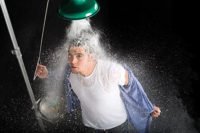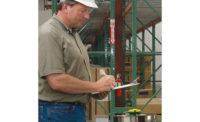Emergency showers & eyewashes

Specifiers are encouraged to assess the specific risk and match the capability of the product to the need set associated with that risk. ANSI also requires an annual equipment inspection.
There are a number of considerations required in specifying and installing emergency showers and eyewashes, driven by the specific needs and risks associated with the business and the requirements of ANSI Z358.1. For ease of understanding, let’s consider them grouped into five general categories of thought:
1Location of the equipment
Per ANSI, emergency equipment must be located within a 10-second unobstructed walk from a potential hazard, on the same level as the hazard. This consideration includes determining both the number of showers/eyewashes and their individual locations.
2 Assure visibility
Providing high visibility, via clear signage, proper lighting and the use of “Safety Green” equipment. Safety green is the color used industrially to designate “safety” and the location of first aid and emergency response equipment, including drench showers and eyewashes.
3Select the right products
There is a wide variety of alternate products available, sometimes with only subtle differences between them. Those subtle differences can become significant when a product is misapplied. Specifiers are encouraged to assess the specific risk and match the capability of the product to the need set associated with that risk.
For instance, using only an eyewash in a chemical plant where liquids form the general risk might not be appropriate. What if an acid or base is splashed onto the face in addition to eyes of a victim? An eye/face wash would be a better fit.
Likewise, features like flow controls and other more recent product advancements assure proper operation when a shower and eyewash are needed simultaneously. Selecting the “right” product also includes assuring that your choice is from the most current generation of products, many of which were designed to meet changes imposed in the latest Z358.1 Standard revision (2004).
Recent advancements, including products designed to emulate the eye irrigation protocols used by the medical community should also be carefully considered. Like most things in life, advancements that are eventually thought of as being a “no-brainer” usually begin as an intuitively better alternative. Do your homework, because all shower and eyewash products are not alike!
4Consider the tempered water requirement
The 2004 revision clarified the tempered water requirement, which was in place rather ambiguously for quite some time. In its current form, Z358.1 requires that outlet water temperatures range from 60º F to below 100º F through the entire required 15-minute drench or irrigation cycle. This was done in recognition of the fact that water that is either too cold or too hot can be physically harmful or — as a minimum can result in the victim short-cutting the required timeframe. Providing tempered water is an often-overlooked requirement that can have serious legal and/or regulatory repercussions.
5Assure proper maintenance
While it might be easy sometimes to say “Not my job,” there is a legal, moral and fiscal responsibility associated with the selection and installation of emergency equipment. That responsibility certainly includes assuring that a process is in place to properly maintain the shower, eyewashes and other associated system componentry. ANSI requires a weekly activation (to assure proper operation and to flush out possible sediment) and an annual (more detailed) inspection. Installing the equipment in such a way as to facilitate the inspections will go a long way to assuring that they are properly done.
For more information on the full range of ANSI-compliant emergency shower and eyewash products visit www.hawsco.com. To arrange a free third-party inspection at your facility, call us at (888) 640-4297.
Looking for a reprint of this article?
From high-res PDFs to custom plaques, order your copy today!




